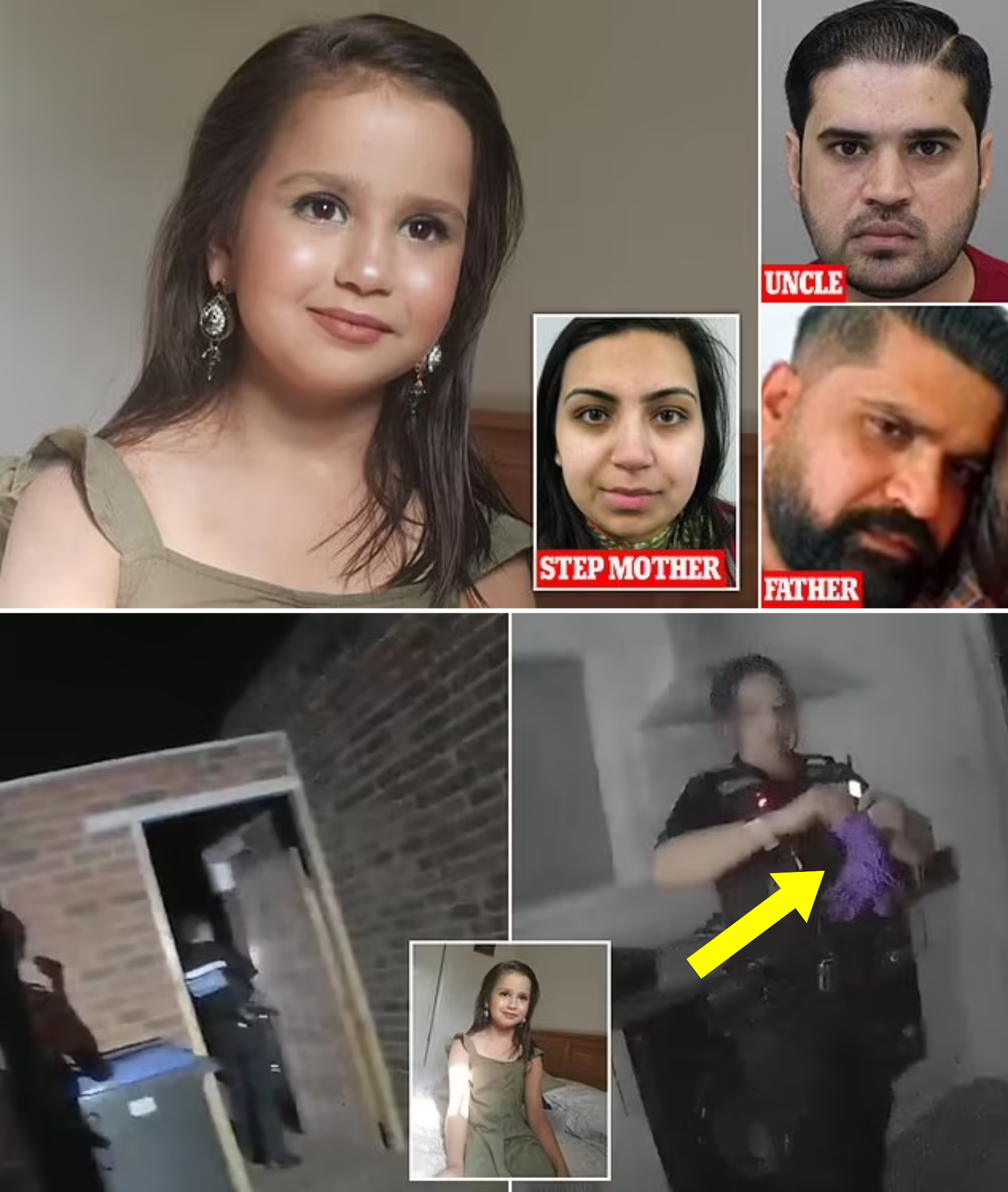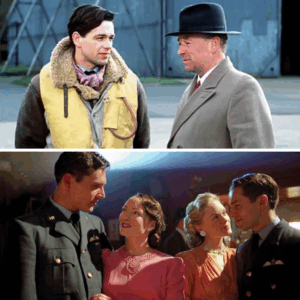
In a courtroom thick with unspoken grief, the faint strains of upbeat music pierced the air as jurors watched a grainy home video of a little girl with boundless energy. Sara Sharif, just 10 years old, twirled and giggled in her family’s living room, her small frame moving with the unbridled joy only a child can muster. She smiled directly at the camera, her dark hair bouncing, her eyes sparkling with mischief. It was a snapshot of innocence, captured on August 6, 2023 – a mere two days before the unimaginable horror that would claim her life.
The footage, allegedly filmed by her stepmother Beinash Batool on her phone, was played to a hushed Old Bailey courtroom on Monday. As the video looped silently on the screen, Batool, 30, sat in the dock, her shoulders shaking with sobs. Her husband, Urfan Sharif, 42, Sara’s father, stared straight ahead, his face a mask of stoic resolve. Beside them, Sharif’s brother Faisal Malik, 29, shifted uncomfortably. The three defendants, charged with Sara’s murder and an alternative count of causing or allowing the death of a child, have pleaded not guilty. But for those few seconds, the room wasn’t filled with accusations or alibis – it was haunted by the ghost of a child who should still be dancing.
Sara’s story is one that has gripped the United Kingdom since her body was discovered on August 10, 2023, hidden under a blanket in a bunk bed at the family home in Woking, Surrey. What began as a routine welfare check spiraled into a nightmare when Sharif, from exile in Pakistan, made a chilling confession to police. In a frantic early-morning call, he admitted to beating his daughter “too much” for being “naughty,” his voice cracking over the line from Islamabad. The family – Sharif, Batool, Malik, and four other children – had fled the UK just 24 hours earlier on a flight to Dubai, then onward to Pakistan. It was a desperate bid for sanctuary that crumbled under the weight of international scrutiny.
Prosecutors paint a portrait of systematic cruelty, a home where love curdled into violence over two agonizing years. A post-mortem revealed a litany of horrors inflicted on Sara’s tiny body: more than 100 external injuries, including bruises, burns, and fractures. There were probable human bite marks on her arm and cheek, an iron burn seared into her flesh, scalding from boiling water that blistered her skin. Her spine bore ten fractures, her collarbone and shoulder blades were shattered, her arms, hands, fingers, ribs, and even the delicate hyoid bone in her neck were broken. Non-fatal bruising marred her brain, suggesting repeated blows to the head. In the outhouse behind the house, investigators found the grim instruments of her torment: a bloodstained cricket bat, a rolling pin smeared with her DNA, a metal pole, a belt, and coils of rope.
“This was not a single act of rage,” prosecutor Bill Emlyn Jones KC told the jury earlier in the trial. “This was a campaign of abuse, escalating to the point where Sara could no longer endure it.” The family had appeared ordinary on the surface – Sharif a cab driver, Batool a homemaker, Malik a McDonald’s worker. Neighbors in the quiet Woking suburb recalled Sara as a shy girl who loved school and dreamed of becoming a doctor. But behind closed doors, her pleas for help went unanswered.
The dancing video, prosecutors say, was no accident. It was a deliberate facade, a way to portray normalcy in the final hours of Sara’s life. Taken in the living room while the TV flickered in the background, it shows Sara shimmying to an unseen tune, her movements fluid and coordinated. She pauses to flash a grin at the lens, waving as if to say, “Look at me!” Forensic pathologist Dr. Nathaniel Cary, cross-examined during the proceedings, agreed: Sara appeared “alert, coordinated, and smiling” – entirely inconsistent with the severe neurological damage that would later be uncovered. There was no visible limp, no hesitation in her step, no sign of the agony she must have been suppressing.
Batool’s defense barrister, Caroline Carberry KC, seized on this. “There is no dispute that Sara endured extensive physical abuse,” she conceded. But she argued the video undermines the prosecution’s timeline of fatal injuries. If Sara could dance like that on August 6, how could the worst of the beatings have occurred just days later? Batool, wiping tears from her eyes as the clip played, has shifted blame squarely onto Sharif. She claims he was the architect of the violence, a man prone to explosive tempers who once fractured her own wrist in a fit of rage. The stepmother portrays herself as a victim too, trapped in a loveless marriage, enduring Sharif’s assaults while trying to shield the children.
Sharif, in turn, has pinned the guilt on Batool. From the witness box last week, he described her as the “controlling” force in the home, the one who wielded the rolling pin and the hot iron. He alleges she orchestrated Sara’s punishments for minor infractions – spilling milk, forgetting homework – and that he only confessed to protect her during that fateful call from Pakistan. A handwritten note found in his belongings echoes this: a supposed admission of guilt, but one he now calls a fabrication born of panic. As for Malik, the uncle, he maintains he was oblivious, a peripheral figure who visited sporadically and never laid a hand on his niece.
The trial, now in its third week, has peeled back layers of dysfunction in the Sharif household. Jurors have heard from Sara’s siblings, now in foster care, who recounted nights of terror: Sara hooded and bound, her cries muffled by gags; the metallic tang of blood in the air after “discipline” sessions. School reports noted Sara’s absences – 23 days in one term alone – and bruises she dismissed as playground tumbles. Social services had flagged concerns, but follow-ups were lax, a systemic failure that has drawn sharp criticism. “How many red flags were ignored?” asked children’s rights advocate Maria Khalid outside court. “Sara was failed by everyone who should have protected her.”
The video’s emergence has added a poignant twist, humanizing Sara in a way the autopsy photos never could. It wasn’t just evidence; it was a window into the girl she was – vibrant, resilient, clinging to joy amid the shadows. As the footage ended, a juror dabbed at her eyes. Even the judge, Mr. Justice Mark Lucraft, paused before proceeding. Batool’s weeping echoed softly, a sound that blurred the lines between perpetrator and penitent.
As deliberations loom, the case raises uncomfortable questions about family, faith, and the hidden epidemics of domestic abuse in immigrant communities. The Sharifs, of Pakistani heritage, navigated cultural expectations of discipline alongside British laws on child welfare – a tension that, in Sara’s case, proved deadly. Activists hope her story sparks reform: stricter monitoring of at-risk homes, better training for teachers spotting abuse, and zero tolerance for cultural excuses.
Sara Sharif’s last dance may have been brief, but its echoes will linger long after the verdicts are read. In a world too often blind to the cries of the vulnerable, her twirls remind us: innocence dances on the edge of darkness, but it deserves a stage where it can flourish, not fade.





